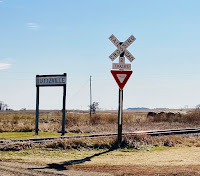Each fall we see large flights of geese heading south. Their brains are tiny, but they know where they’re going. I’ve often thought about such things like wondering where I’d be without a map if I were to head south for the winter. Before the early surveyors applied their grids to the land and outlined states, counties, and townships, I would’ve needed a primitive method, maybe steering by the north star, following a path someone else had cut, or heading towards some landmark on the horizon.
A great example of an early survey, maybe the first, can be found in Ransom County at the Standing Rock Hill Historical Site located east of the Little Yellowstone Park just off Highway 46. A passable two-track trail takes a vehicle to the top where the view of the countryside is remarkable. Geologists took an interest in the hill because of the way it was created approximately 14,000 years ago. The rock itself rode a glacier from Ontario, Canada, and the dirt in the hill was pushed over three miles by the same wall of ice. It left lakes and sloughs in its path and when you look to the northeast from atop the hill, you can see a sizable amount of water shining in the sunlight.
As for the survey, it occurred about 1839 when two explorers, Nicollet and Fremont, accompanied with about twenty men, came through this part of the country. Joseph Nicollet was a Frenchman with skills in astronomy, mathematics, and cartography whose goal was to explore and map the upper Mississippi area. His partners were a botanist named Charles Geyer, and John C. Fremont, a seasoned scout.
Nicollet made accurate maps most likely with the use of a sextant and aided by a barometer he determined altitude. These explorers noted the Standing Rock site on their maps which Indians called Inyan Bosndata. The hill on which it stands is the highest around and stands at 1490 feet which is about 25-30 higher than Bears Den Hillock near the fort. The stone itself sits upright on another level higher yet. State historical accounts assert that the top level is man-made, probably by those Indians who used it for their ceremonials and offerings.
Little thought was given at the time to matters of conservation. Nicollet marveled at the huge herds of buffalo, but when trains started opening the country, passengers were thrilled to shoot them as they passed by. It wasn’t until the beasts were almost eradicated that efforts sprang up to save them.
The first accounts of explorers describing what is now Yellowstone Park weren’t believed. John Colter had accompanied Lewis and Clark when they passed through this territory in 1804. He had an innate sense of exploration and in 1807–1808 became the first known person of European descent to enter Yellowstone region. His unbelievable descriptions of geysers, bubbling mudpots, and steaming pools of water were not taken seriously. Colter’s the one when captured by Indians was stripped naked and told to run for his life. He successfully evaded recapture.
The skeptical public started believing stories about the scenery when artists entered the area and painted its beauty and wonders. Thomas Moran’s paintings captured the nation's attention and helped inspire Congress to establish the Yellowstone region as the first national park in 1872.
The other day I saw a reference to a new book by David Gessner, an author whose previous book, ALL THE WILD THAT REMAINS, looked at two American conservationists: Edward Abbey and Wallace Stegner. The new book, LEAVE IT AS IT IS, considers conservation from Theodore Roosevelt’s viewpoint. In writing the two books, Gessner traveled through the west camping, visiting with locals, studying history, all the while trying to determine some answers for himself about the state of American conservation efforts. Stegner was the more academic and well-reasoned of the two while Abbey was of the “monkey wrench” mentality.
We’ve heard much of Roosevelt and his conservation efforts. He took action by creating five national parks, eighteen national monuments, fifty-one federal bird reserves, four national game preserves, created the U. S. Forest Service, plus one hundred and fifty national forests. Whew! He did have critics for his actions, though, something which I’ve learned in my personal life. Gessner said, “If you take a stand, half the people will be standing against you.”
Readers can argue this ends pretty far afield from where I started with the Standing Rock Hill Historic Site. I argue it exists today because someone recognized its worth for the future place in our local history. There really is quite a bit of history out there; it just needs to be found and remembered.





